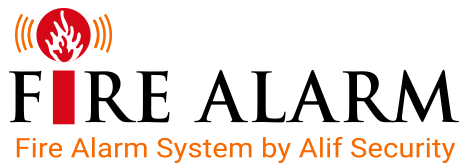Can the fire alarm cable be exposed: Safety, Regulations, and Considerations

Fire alarm systems are crucial for safeguarding lives and property during emergencies. One common question that arises during their installation is whether fire alarm cables can be exposed. In this comprehensive guide, we will explore the key safety considerations and regulations associated with exposed fire alarm cables.
Can the fire alarm cable be exposed?
Yes, Fire alarm cables can be exposed as long as specific safety measures and regulations are followed to ensure their integrity and functionality. According to the National Electrical Code (NEC) Article 760, exposed fire alarm cables are allowed above 7 feet from the floor, reducing the risk of accidental contact or damage. Below this height, cables should be protected in a raceway. It is essential that these cables are supported by the building structure, such as baseboards, door frames, and ledges, and installed in a neat, workmanlike manner to prevent damage and ensure reliability. In particular areas, like mechanical rooms, rooms without ceilings, or above hard ceilings, conduits may be necessary, and flexible metal conduit can be used where installing hard conduit is difficult. Additionally, fire alarm cables should be insulated with heat-resistant materials that do not produce toxic smoke when burned.
Key Points:
- Fire alarm cables can be exposed if they are protected from physical damage.
- NEC Article 760 allows exposed cables above 7 feet; below 7 feet, cables should be in a raceway.
- Cables must be supported by the building structure to prevent damage.
- Install cables in a neat, workmanlike manner.
- Use conduit in mechanical rooms, rooms without ceilings, or above hard ceilings; flexible metal conduit can be used if hard conduit installation is challenging.
- Insulate cables with heat-resistant material that does not emit toxic smoke when burned.
The decision to expose fire alarm cables should be made thoughtfully, balancing local building codes, cable types, safety, and aesthetics. While it is possible to install fire alarm cables in an exposed manner, it must be done in strict compliance with safety standards and regulations. Always prioritize safety, consult local codes, and strike a balance between aesthetics and the need for a fully operational fire alarm system.
Collaborating with qualified fire alarm system professionals who are well-versed in local codes and regulations is pivotal to ensuring a compliant and safe installation. Remember that the safety and functionality of the fire alarm system are of utmost importance in safeguarding lives and property.
- Aldine
- Alvin
- Ames
- Anahuac
- Angleton
- Arcola
- Atascocita
- Austin
- Bacliff
- Bailey Prairie
- Barker
- Barrett
- Bay City
- Bayou Vista
- Baytown
- Beach City
- Beasley
- Beaumont
- Bellaire
- Boling
- Bonney
- Brazoria
- Brazos Country
- Brookshire
- Brookside Village
- Bunker Hill Village
- Cedar Park
- Channelview
- Cinco Ranch
- Clear Lake Shores
- Cleveland
- Cloverleaf
- Clute
- Conroe
- Corsicana
- Cove
- Crosby
- Cumings
- Cut And Shoot
- Cypress
- Damon
- Danbury
- Dayton
- Dayton Lakes
- Deer Park
- Dickinson
- East Bernard
- El Lago
- Fairchilds
- Fifth Street
- Fort Bend
- Four Corners
- Freeport
- Fresno
- Friendswood
- Fulshear
- Galena Park
- Galveston
- Grand Prairie
- Greatwood
- Guy
- Hardin
- Harris
- Hedwig Village
- Hempstead
- Highlands
- Hillcrest
- Hilshire Village
- Hitchcock
- Hockley
- Holiday Lakes
- Houston
- Huffman
- Hufsmith
- Humble
- Hungerford
- Hunters Creek Village
- Huntsville
- Iago
- Iowa Colony
- Jacinto City
- Jamaica Beach
- Jersey Village
- Katy
- Kemah
- Kendleton
- Kenefick
- Kingwood
- La Marque
- La Porte
- Lake Jackson
- League City
- Liberty
- Liverpool
- Livingston
- Lorena
- Magnolia
- Manor
- Manvel
- Meadows Place
- Mission Bend
- Missouri City
- Mont Belvieu
- Montgomery
- Morgans Point
- Nassau Bay
- Navasota
- Needville
- New Territory
- North Cleveland
- North Houston
- Oak Island
- Oak Ridge North
- Old River-Winfree
- Orange
- Orchard
- Panorama Village
- Pasadena
- Pattison
- Patton Village
- Pearland
- Pecan Grove
- Pine Island
- Pinehurst CDP
- Piney Point Village
- Pleak
- Plum Grove
- Port Arthur
- Porter
- Porter Heights
- Prairie View
- Richardson
- Richmond
- Richwood
- Roman Forest
- Rosenberg
- Rosharon
- Sabine Pass
- San Antonio
- San Felipe
- San Leon
- Santa Fe
- Seabrook
- Sealy
- Seguin
- Sheldon
- Shenandoah
- Shoreacres
- Silsbee
- Simonton
- South Houston
- Southside Place
- Splendora
- Spring
- Stafford
- Stagecoach
- Sugar Land
- Taylor Lake Village
- Texas City
- The Woodlands
- Thompsons Alief
- Tiki Island
- Todd Mission
- Tomball
- Waller
- Wallis
- Webster
- West Columbia
- West University Place
- Weston Lakes
- Willis
- Woodbranch
- Woodloch


